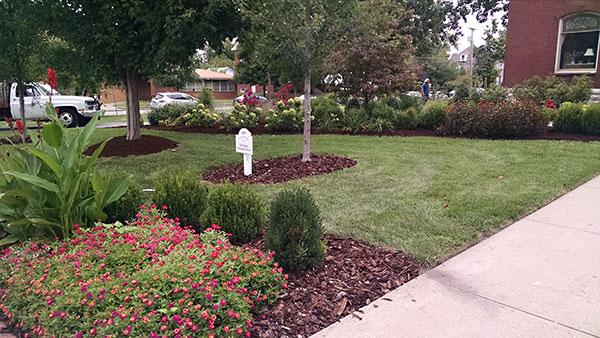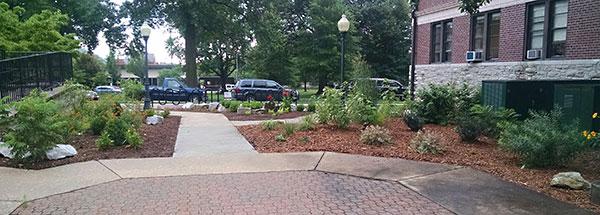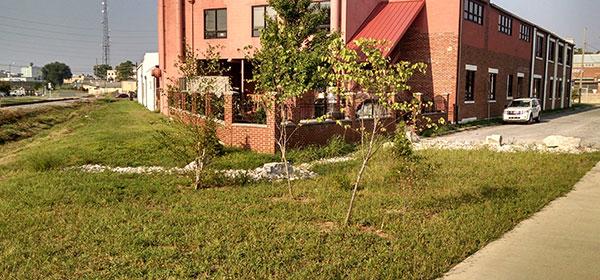Sustainability, Budget, and the Landscape Design Concept
Writing a recent blog about the future of grounds and landscaping got me thinking about how potential future changes could alter what my grounds management looks like. It then lead me to wonder about sustainability (what in the world does that mean?), and how that could change my grounds management too. The possible changes stem from the pursuit of sustainability that is being advocated by both those in our industry and those outside of it. But which pursuit the right one?
Sustainability... yet another definition
One of the main definitions of sustainability I have heard is managing resources so that you do not limit subsequent people's ability to manage those same resources. Basically I would say that translates to leaving the resources to later managers in the same condition you found them. It can also mean not using more than your fair share. All of these sound good, but I don't think they get to the root of the problem.
My definition of sustainability focuses on the sustain root of the word. I ask myself the question, if I walk away, will my landscape sustain? This is to say, will it keep doing what I want it to do without intervention or resource consumption? I imagine that there are a number of people saying that is impossible. I very nearly agree that it is impossible. But even if impossible, pursuing a landscape that can sustain leads me to pursue a landscape that is as sustainable as possible.

High maintenance landscapes, like this area near the President's House, are resource intensive.
The contradiction
There is contradiction between the landscape grounds managers are tasked with pursuing and the pursuit of a landscape that can be sustained. These landscape objectives are too frequently created by people with no horticultural understanding if they are actually obtainable. In spite of recent efforts at sustainability, the paradigm of the modern landscape is still resource intensive. Irrigation, chemicals, plant material, organic matter, fertilizers, fuel for machines are all needed to maintain the current iteration of the landscape. For golf courses and sports fields, this is easily rationalized due to what the purpose of those landscapes is. But for a college campus, why are we trying to design, install and maintain a landscape that requires significant resources, all the while trying to figure out how to diminish resource consumption (save money)?

Stylized native plantings require fewer resources
The budget contradiction
I want everyone to try an exercise. Go to whomever sets and approves your landscape maintenance budget and tell them you need more money to do your job. See what they say. After they tell you that there is no new money forthcoming, and 18 reasons why your budget has been the same for the last four years, leave and go to work. The next day, go to the same person and tell them you want to decrease the mowing frequency for certain logically determined low maintenance areas to every two weeks and see what they say. After they tell you to hold the line on quality in these areas, and urge increasing mowing frequency at the high visibility areas, leave and go back to work, this time shaking your head (or fists). Because what the people who dictate landscape expectations want from the landscape is very seldom what they budget for.
If you want sustainability, cut the budget
Spending money will not achieve sustainability. Buying efficient blowers and mowers that run on natural gas allows us to believe that we are being sustainable. But this is postpone-ability, not sustainability. We are still being forced to participate in the resource intensive maintenance regime of mowing, blowing and irrigating. We still cannot walk away from the landscape and have it do what we want it to. If my mowing budget was slashed, I would have to focus mowing on high visibility areas and athletic fields, thereby saving a lot of resources. This would then require everyone adjusting to taller grass, more off-target plant percentage, and require that we change the plant mix to shrubs and perennials. Changing our landscaping goals to those that are sustainable, and away from those that are not, would make a lot of financial sense.

Secondary areas can be minimally maintained.
The goal (desired landscape image) never changes
Ecosystems are inherently dynamic and ever changing. Any number of environmental impacts can change the influences that dictate what can thrive in an area. Landscaping interventions usually attempt to freeze a system in an artificially maintainable state. That is why we mow grass and prune shrubs. As stated before, this unchanging state (predictability) is rational for golf and baseball, but is difficult to rationalize (given sustainability goals), and even harder to maintain, on a campus (or peripheral areas). Barring recreational areas, how does the ornamental landscape educate students? Sustainable landscaping must be diverse and based on a diverse set of customer needs, not based on budgetary decisions, or tradition.



0 Comments
Recommended Comments
There are no comments to display.